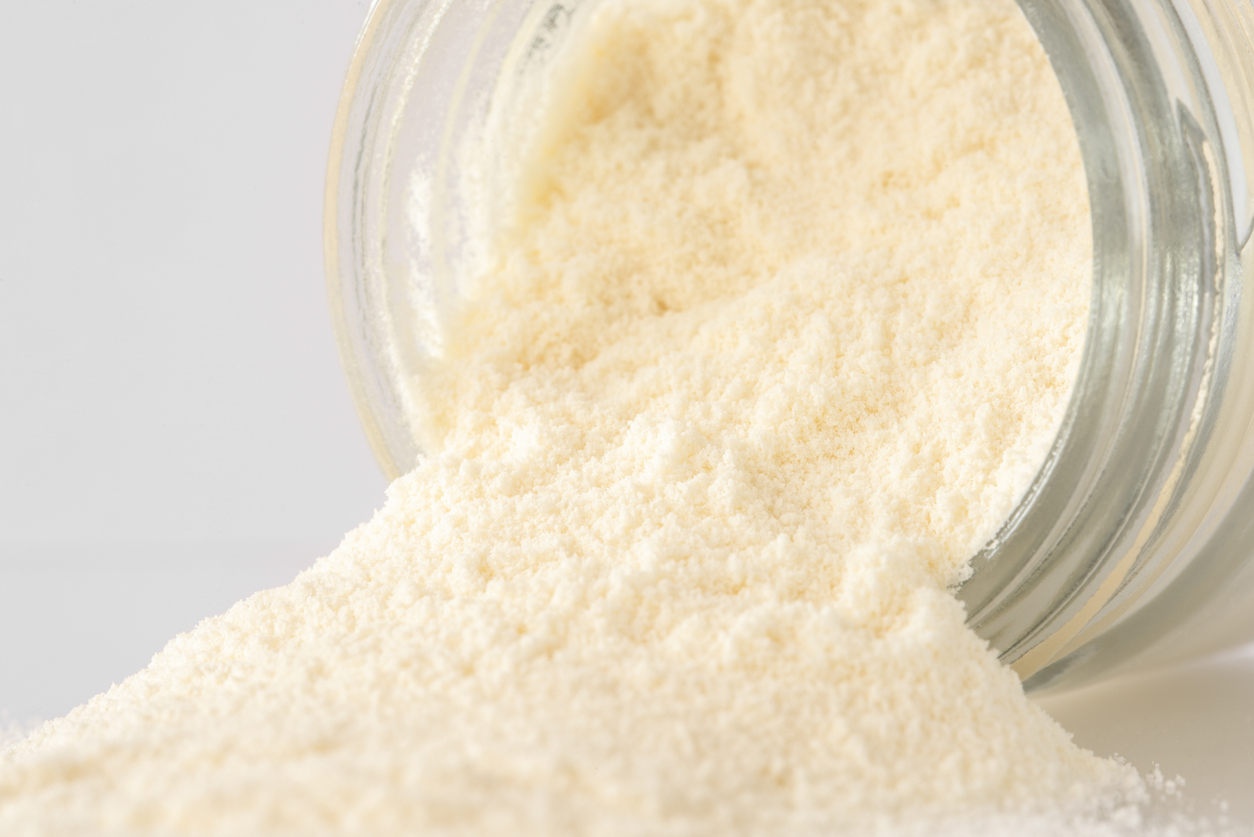The gut and immune system are connected via an intricate network of relationships, which scientists call the “gut–immune axis.”
Lactoferrin, a glycoprotein found in the milk, tears, and saliva of mammals, is an important nutrient for the gut–immune axis. It has well-established antimicrobial and immunomodulatory properties. Multiple studies have demonstrated how lactoferrin promotes the growth of beneficial gut bacteria, reduces intestinal inflammation, prevents diarrhea, and enhances systemic immune responses.
In this blog post, we’ll review the latest research on the gut and immune benefits of bovine lactoferrin. We’ll explore its prebiotic, anti-inflammatory, and antimicrobial effects, and we’ll discuss how to incorporate it into your daily routine so you can experience its remarkable benefits.
The gut health benefits of lactoferrin
The gut-associated lymphoid tissue, or GALT, is located in the lining of the gastrointestinal (GI) tract. It includes various types of lymphoid tissues like the tonsils, adenoids, and Peyer’s patches. These tissues are designed to detect and react to potential threats like bacteria, viruses, and other foreign substances. Scientists estimate that 70 percent of the immune system resides in the GALT. Moreover, about 80 percent of immunoglobulin A cells—critical to immune function—are found in our gut. (*)
This explains why an unhealthy gut microbiome can cause inflammation, weaken our immune defense against pathogens, and trigger autoimmunity, allergies, and other imbalances of the immune system.
Bovine lactoferrin offers multiple gut health benefits, making it a useful supplement for optimizing the GI system.
Prebiotic effects
One key mechanism is its prebiotic effect of selectively promoting the growth of beneficial bacteria. Studies show bovine lactoferrin increases populations of Bifidobacteria and Lactobacilli in the gut while inhibiting pathogens like Escherichia coli,Salmonella, and Clostridium. (*) The antibacterial effects of lactoferrin are due to its ability to bind iron, an essential nutrient for bacterial growth. By sequestering iron, lactoferrin creates an unfavorable environment for iron-dependent pathogenic bacteria.
Anti-inflammatory effects
Bovine lactoferrin is also a potent anti-inflammatory compound. It blocks the release of pro-inflammatory cytokines like tumor necrosis factor-alpha (TNF-alpha), interleukin-1 (IL-1), and interleukin-6 (IL-6). It enhances the secretion of the anti-inflammatory cytokines interleukin-10 (IL-10) and interleukin-4 (IL-4). Lactoferrin binds to lipopolysaccharide, a toxin produced by gram-negative bacteria in the gut, preventing it from entering the bloodstream. (*)
Lactoferrin’s anti-inflammatory properties make it an obvious choice for inflammatory bowel disease (IBD), celiac disease, and other digestive diseases. So, it’s no surprise that studies have shown that supplementing with bovine lactoferrin provides benefits in these situations.
For example, one study found that bovine lactoferrin supplementation protected against inflammation and “leaky gut” by regulating the microbiome and reducing the production of pro-inflammatory cytokines. (*)
However, inflammation in the gut is also a trigger for many other conditions, from autoimmune disease to allergies, depression, dementia and Alzheimer’s disease, type 2 diabetes, and osteoporosis. Lactoferrin’s ability to reduce gut inflammation suggests that it may benefit a wide range of health problems that aren’t explicitly gut-related.
That’s precisely what we see in the scientific literature. Studies have shown that lactoferrin is critical in bone remodeling, regulating the function of osteoblasts, chondrocytes, osteoclasts, and mesenchymal stem cells. Lactoferrin supplementation promotes bone fracture repair and reverses osteoporosis in animal studies. (*)
Another study found that lactoferrin supplementation “alleviated Western diet-induced cognitive impairment through the microbiome–gut–brain axis.” Lactoferrin reduced inflammation in the brain, repaired the gut barrier, and increased the abundance of beneficial bacteria, leading to improved cognitive function on behavioral tests. (*)
Intestinal barrier effects
Lactoferrin strengthens gut integrity by increasing mucus production and preventing endotoxins from leaking out of the intestine into the bloodstream. (*) Protecting the function of the gut barrier is enormously important for both gut and immune health. We now know that many modern, chronic diseases—including those I listed above—are characterized by intestinal permeability (aka “leaky gut”). Lactoferrin is also effective for repairing disruptions to the gut barrier caused by chronic stress or a course of antibiotics. (*)
The immune health benefits of lactoferrin
Beyond the gut, bovine lactoferrin also provides wide-ranging immune health benefits.
Antimicrobial effects
Lactoferrin exhibits direct antimicrobial activity against bacteria, viruses, fungi, and parasites by damaging microbial membranes.
As noted above, the antimicrobial properties of lactoferrin stem from its ability to bind iron, an essential nutrient for the growth and metabolism of pathogens. By sequestering iron, lactoferrin creates an iron-deficient environment that restricts microbial proliferation.
Research shows lactoferrin inhibits the growth of both gram-positive and gram-negative bacteria. It acts on common foodborne pathogens like E. coli, Salmonella, Listeria, and Staphylococcus aureus. Lactoferrin also demonstrates antibacterial activity against Helicobacter pylori, the bacteria that causes gastric ulcers. (*)
In addition to bacteria, lactoferrin has antiviral effects against an array of viruses, including rotavirus, hepatitis C, HIV, cytomegalovirus, herpes simplex virus, and poliovirus. It interferes with viral attachment, entry, and replication in host cells. (*)
Lactoferrin also exhibits antifungal properties against Candida albicans and other pathogenic fungi by destabilizing their cell membranes. Parasites like Plasmodium and Toxoplasma gondii are also inhibited by lactoferrin’s ability to bind surface proteins that mediate host cell invasion. (*)
Besides iron depletion, lactoferrin may exert direct antimicrobial effects by interacting with microbial membranes to cause membrane disruption and leakage of intracellular contents. Its antimicrobial actions likely involve multiple synergistic mechanisms.
Overall, the broad-spectrum antimicrobial potency of lactoferrin makes it a promising natural compound for preventing or treating infections by harmful bacteria, viruses, fungi, and parasites. Its multifaceted antimicrobial activities help reduce pathogen colonization and virulence.
Anti-inflammatory effects
In addition to lactoferrin’s anti-inflammatory effects in the gut, it can help resolve inflammation following infection or injury. It scavenges free radicals that would otherwise damage cells and tissues. These combined actions support the body’s natural immune defenses and healing capabilities.
Scientists have noted lactoferrin’s unique ability to “sense” the immune activation status of an organism and act accordingly. (*) This likely contributes to lactoferrin’s demonstrated benefits in a wide range of inflammatory conditions.
Immunomodulatory effects
Lactoferrin has the remarkable ability to both stimulate and suppress the immune system. As an immunomodulator, it can enhance weak immune responses against pathogens (like viruses and bacteria) while simultaneously tamping down on hyperactive immune responses (like allergies and autoimmunity) and reducing excessive inflammation.
This unique “dual action” is what makes lactoferrin so useful. Most compounds—whether natural or pharmaceutical—can only boost or suppress the immune system. For example, steroids can powerfully reduce inflammation in people with autoimmune diseases. But this benefit comes at the expense of strongly suppressed immune defenses.
On the other hand, botanicals like Echinacea and Astragalus can boost our ability to fight viruses and bacteria. However, they can overstimulate the immune system in susceptible people, provoking or exacerbating allergic or autoimmune reactions.
Lactoferrin bolsters both innate and adaptive immunity. It mobilizes immune cells like macrophages, neutrophils, and natural killer (NK) cells that engulf pathogens and infected cells. Lactoferrin also boosts the proliferation of B and T lymphocytes and increases antibody production. (*)
Lactoferrin enhances the activities of antioxidants like catalase, superoxide dismutase (SOD), and glutathione, which reduce oxidative stress that can impair immune function. (*) Its effects on gene expression likely contribute to immunomodulation. Lactoferrin upregulates genes related to cell proliferation while downregulating pro-inflammatory genes. (*)
Anticancer effects
In addition to its antimicrobial and immunomodulatory activities, emerging research indicates bovine lactoferrin may also have anticancer properties. Several possible mechanisms have been proposed: (*)
- Antioxidant effects. Lactoferrin is a potent antioxidant that neutralizes DNA-damaging free radicals and reactive oxygen species linked to cancer development. This helps reduce oxidative stress and mutual mutations.
- Anti-inflammatory effects. By inhibiting the release of pro-inflammatory cytokines, lactoferrin suppresses chronic inflammation, which often precedes cancerous growths. It also impedes signaling pathways that promote the proliferation of cancer cells.
- Lactoferrin stimulates anticancer activities of immune cells like NK cells, cytotoxic T cells, and macrophages. This bolsters immune surveillance against mutated cancerous cells.
- Cell cycle arrest. Lactoferrin has been shown to block cell cycle progression and induce apoptosis in human cancer cell lines of the colon, liver, lung, breast, and bladder. This directly inhibits tumor growth.
- Anti-metastasis. Lactoferrin appears to block mechanisms involved in the degradation of extracellular matrix and basement membranes. This may prevent metastasis and adhesion of circulating cancer cells.
- Synergy with chemotherapeutics. Lactoferrin seems to enhance cancer cell sensitivity to pharmaceutical drugs. It may also reduce the side effects of standard chemotherapy regimens.
While human trials are still limited, bovine lactoferrin has shown promising anticancer potential through its effects on cell signaling, oxidative stress, inflammation, and immunity. Research is ongoing, and we will likely see new studies published soon.
Who might benefit from lactoferrin?
As you’ve learned from this article, lactoferrin has an incredibly diverse range of benefits. As a Functional Medicine clinician, I’ve used lactoferrin with patients for over 15 years with fantastic results. It’s one of my “go-to” nutrients because it’s both gentle and powerful—a rare combination.
These are the conditions/situations in which I tend to use lactoferrin most often:
- Digestive illnesses (e.g., irritable bowel syndrome [IBS], IBD, gastroesophageal reflux disease [GERD])
- Allergies and asthma
- Autoimmune disease
- Weak immunity (i.e., frequent colds, flu, or other infections)
- Skin conditions (e.g., acne, eczema, psoriasis)
- Iron deficiency (while not covered in this article, lactoferrin is an iron-binding protein and significantly improves iron absorption)
This is not an exhaustive list, as lactoferrin will benefit many other conditions (given the mechanisms described above).
How to get the benefits of lactoferrin
Lactoferrin is present in small amounts in dairy products like cheese and yogurt and to an even lesser degree in beef and other meats. Dairy and meat from pasture-raised cows tend to have higher levels of lactoferrin.
Lactoferrin is also present in colostrum, the milk-like fluid that serves as the first food for all mammals (including humans).
That said, if you want to get meaningful doses of lactoferrin, you’ll need to supplement. The recommended daily dose of lactoferrin is 100 to 200 mg. The amount of lactoferrin in cow’s milk is just 0.5 mg/L, or roughly 10 to 15 mg per 8 ounces. Colostrum supplements contain approximately 0.3 to 0.5 percent lactoferrin by volume or 3 to 5 mg per gram. While cow’s milk and colostrum provide some lactoferrin, it would be difficult to obtain the recommended daily dose through these sources alone.
Bovine lactoferrin is generally recognized as safe by the US Food and Drug Administration (FDA). It’s well-tolerated by humans with minimal adverse effects.
Conclusion
It’s no exaggeration to say that optimizing the gut–immune axis is one of the most important steps we can take toward improving our health and expanding our life span. Virtually all modern, chronic diseases involve pathological changes in the gut and immune system, so attending to these areas of our health can pay huge dividends.
A growing body of research indicates bovine lactoferrin could be a natural and safe supplement to help achieve this goal. Its antimicrobial, anti-inflammatory, and immunomodulatory properties provide a one-two punch to support gut health and immunity simultaneously.
In the world we live in today, protecting and supporting our immune system is paramount to living a long, healthy life. Lactoferrin should be at the top of the list—along with colostrum, beta-glucan, and probiotics—for supporting the gut–immune axis.


